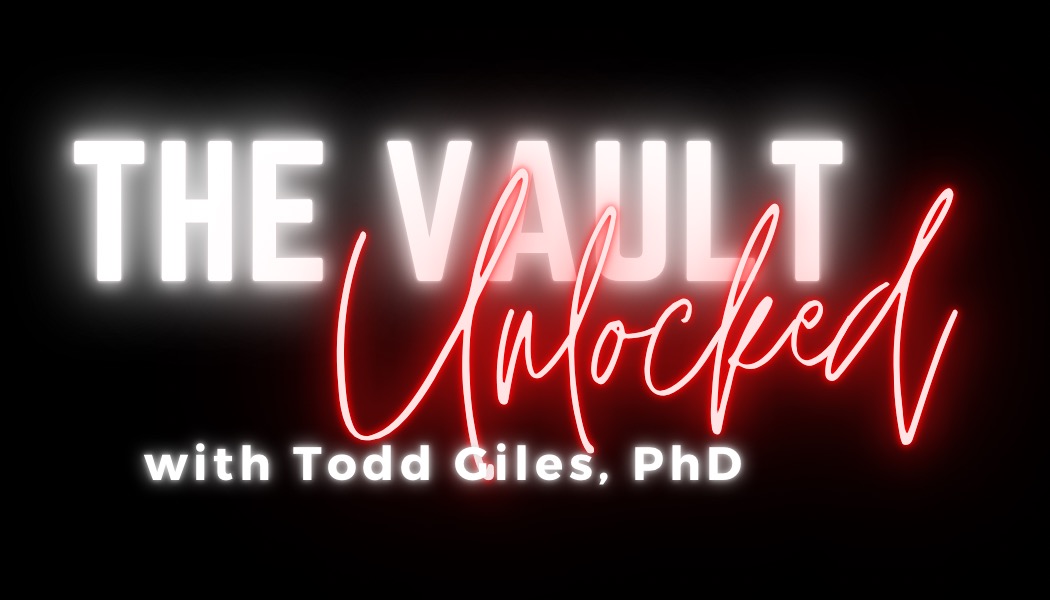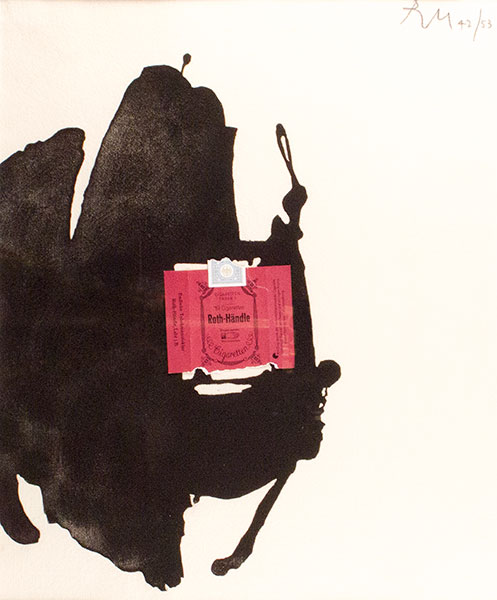
Ever wonder where the art is stored at the WFMA, and what's in there anyway? Join MSU professor Todd Giles as he unlocks the vault!

Robert Motherwell
Roth-Händle, 1974
Aquatint and collage
Auvergne a la Main handmade paper
19 3/4" x 15 3/4”
Museum purchase assisted by the National Endowment for the Arts, 1975
“The sensation of physically operating in the world is very strong in the medium of papier colles or collage, in which various kinds of paper are pasted to the canvas. One cuts and chooses and shifts and pastes, and sometimes tears off and begins again. In any case, shaping and arranging such a relational structure obliterates the need, and often the awareness, of representation. Without reference to likeness, it possesses feeling because all the decisions in regard to it are ultimately made on the grounds of feeling.”
~ Robert Motherwell (qtd. in Heller 260)
The genesis of the printmaking renaissance in the United States after World War II was Universal Limited Art Editions, a lithography workshop operated in the garage of Tatyana and Maurice Grosman on Long Island in New York. ULAE opened its doors in 1957 to those who would become some of the most influential American artists of the following two decades. In 1960, Mrs. Grosman invited a young Neo-Dada/Pop artist Jasper Johns to produce his first prints in her studio; the following year, Abstract Expressionists Helen Frankenthaler and Robert Motherwell made their first prints with Mrs. Grosman. Robert Rauschenberg and Jim Dine also joined ULAE’s lineup in 1961, the same year New York School poet James Schuyler wrote an article in Art News asking the question: “Is there an American print revival?” The answer, according to Schuyler, was a resounding “Yes!”
What drew these and other artists to Mrs. Grosman’s studio was her determination that their work on paper should equal the quality and originality of their work on canvas. To this end, she commissioned handmade papers and published only the best prints by each artist. Thanks to ULAE and the other workshops that opened in California and New York, printmaking in America for the first time matched the beauty, complexity, and vitality of the monumental postwar canvases being produced by the Abstract Expressionists and Pop artists.
Motherwell, who was the youngest of the original group of Abstract Expressionists, was also the most well-educated; he studied philosophy at Harvard, and in 1938-39 he spent a year abroad writing his MA thesis on Delacroix and studying French art from Symbolism to Surrealism. Surrealism’s use of automatism in writing and painting—that is, psychically disrupting the mind’s normal thought patterns and embracing instead unconscious forms and seemingly inexplicable juxtapositions—was key to Motherwell’s development as a young artist and philosopher.
At the suggestion of French artist Marcel Duchamp, who was living in New York at the time, the great patron and art collector Peggy Guggenheim put together the first American exhibition dedicated entirely to collage at her Art of this Century Gallery in 1943. Along with notable European artist such as Pablo Picasso, George Braque and Joan Miro, young Americans Jackson Pollock and Robert Motherwell—neither of whom had yet worked in collage—were also included. Unlike Pollock, the experience was so important to Motherwell that he continued to work in collage for the rest of his life.
Although Motherwell first began experimenting with printmaking in 1942 by producing some etchings at one of the other major studios in New York, William Hayter’s Atelier 17, his expressionist vocabulary was most successfully met with the lithographer’s stone at ULAE between 1961 and 1965, where he produced seventeen prints. Between his experiments with etching in the early 40s and his passing in 1991, Motherwell made some 300 prints at various studios, exploring the medium of printmaking in more depth and diversity than any of his Abstract Expressionist contemporaries.
A few words on process. Aquatint, which is the printmaking process in which Motherwell’s 1974 Roth-Händle was executed, is a form of etching. The process creates tones by covering areas of a copper or zinc etching plate with an acid-resistant resin that is adhered to the plate with heat. Rather than cutting lines directly into the plate itself, as in drypoint etching, the artist makes marks on top of the resin using an oil-based crayon or other form of ground. When the plate is immersed in acid, the acid eats into (etches) the unworked areas that are not resistant to the acid, creating the tone and texture seen once the plate is inked and run through a press. Lithography, on the other hand, involves drawing on a plate or stone with a greasy substance, which is then processed with nitric acid and gum arabic. The surface is dampened with water, which is repelled by the greasy areas. When rolled with ink, the ink adheres to the drawn areas but is repelled by the wet areas of the plate or stone. The inked image is likewise transferred to a sheet of paper through the pressure of the press.
According to Motherwell, “What aquatint can do . . . better than the other means of a painter, is to saturate certain mould-made papers with an intensity of hue that cannot be equaled. . .” (qtd. in Terenzio 112). Although Motherwell is primarily known for the large, deeply saturated black amorphous shapes that appear on many of his canvases, he rarely employed intense black patches in his prints, particularly in the 1960s, when he was primarily interested in exploring collage, thin lines, and large fields of color (Castleman 137-138). Eventually, though, he brought to bear his collage technique and work with black in his prints as well, as seen in Roth-Händle, with its saturated yet varied tonal texture, which speaks back to his work with paint and canvas.
Motherwell was so enthralled with printmaking that he installed an etching press in his Greenwich, Connecticut studio in 1973. A year later, Roth-Händle was printed with the help of Catherine Mousley, his newly-hired printmaker. Mousley would lay out 10-12 prepared etching plates or stones of various sizes in the studio for Motherwell to compose on, often simultaneously. When he was done, Mousley would etch them at her own studio, followed by making proofs to share with the artist. Those that needed more work went through successive states of composition until Motherwell was happy with them. The composition process of Roth-Händle, for example, went through nine such trial proofs, with the artist and printmaker experimenting with the inclusion and placement of different cigarette labels.
As Motherwell says in the epigraph above concerning collage work versus that of representational art, “Without reference to likeness, it possesses feeling because all the decisions in regard to it are ultimately made on the grounds of feeling.” Once he got the feel of Roth-Händle right, its final state, which was produced in a run of 53 prints, included not actual cigarette labels but a two-color photo-offset of a Roth-Händle label that was folded and torn to resemble the real thing.
We tend to think of Abstract Expressionism, like jazz, as one of the only truly American art forms. That sentiment is largely true, but when we consider how influenced artists like Motherwell were by the large number of European artist-refugees living and working in New York in the 40s and 50s, including the influence of Surrealist automatism and the collage work of the Cubist masters, it is easy to see just how firmly that connection remained between the heart of European Modernist experimentation and that of postwar America creativity.
Works Consulted
Acton, David. Stamp of Impulse: Abstract Expressionist Prints. Worcester Art Museum, 2001.
Castleman, Riva. Prints of the Twentieth Century: A History. Museum of Modern Art, 1976.
Heller, Jules. Printmaking Today: A Studio Handbook. Holt, Rinehart and Winston, Inc., 1972.
Sparks, Esther. Universal Limited Art Editions, A History and Catalogue: The First Twenty-Five Years. Harry N. Abrams, Inc., Publishers, 1989.
Terenzio, Stephanie. The Prints of Robert Motherwell: A Catalogue Raisonné 1943-1990. Hudson Hills Press, 1991.
Wilkin, Karen. “Motherwell’s Magical Collages.” The New Criterion (Dec. 2013): 30-33.
Roth-Händle from the Permanent Collection of the Wichita Falls Museum of Art at MSU Texas
View Previous The Vault Unlocked
-
Tuesday - Friday
10:00AM - 5:00PMSaturday
1:00PM - 5:00PM